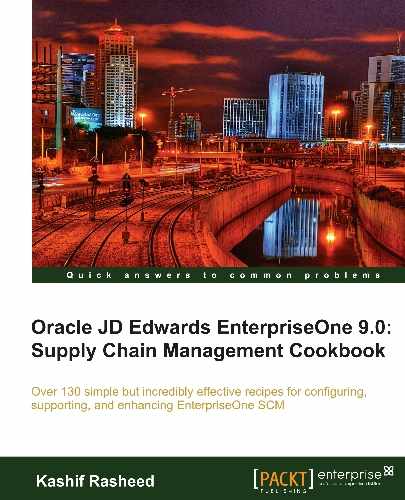This recipe provides the information for tracking and tracing a faulty lot, and discusses how to:
- Review lot trace and track information
- Search for lots by supplier or supplier lot number
Before viewing a lot transaction, you must set up the processing option of Lot Trace/Track Inquiry (P41203).
- From Inventory Management (G41) Menu | Daily Processing | Lot Control | Trace/Track Inquiry, click on the arrow, and then click Values.

- On the Display tab, specify which method the system uses to trace or track lot usage.
- If you choose to trace the lot, the system traces, from the time of shipment to the time of manufacture, all of the items that made up the current item.
- If you choose to track the item, the system determines all of the assemblies of which this item is to be a component, from the time of manufacture to the time of shipment.
- On the Display tab, specify the level at which the Trace/Track result is to be displayed.
- If you leave the Document Type processing option blank, the system automatically uses a default document type of IM.
- If you leave the Defaults tab processing option blank, the system automatically provides the default document type OP.
- If you leave the Version tab processing option blank, the system assigns the ZJDE0001 version as the default version.
- View the Lot Control (G4113), Trace/Track Inquiry | Lot Management Workbench, on the lot Management Workbench form select Supplier Lot Inquiry from the Form menu.

You can use lot tracing to view the transactions in which items were assigned to the lot. If the lot contains kits or assembled items, you can identify the parts that were used to assemble items in the lot, as well as the lots from which the parts came. You use lot tracking to view the transactions in which items were removed from the lot. You can identify items that have been assembled using parts from the lot, and the lots to which the assembled items were assigned. You provide information about how you want the system to trace and track lots. For example, you specify the document types that the system monitors to Trace and Track lots. You also specify whether you want to view transactions for assembled items or non assembled items, by specifying a Trace and Track mode. You can trace a component or ingredient lot back to the immediate supplier in those cases where faults are found with the lot. Y ou must also identify active orders that are associated with lots containing faulty or recalled components, assess the impact, and process product recalls effectively. This procedure lets you reduce unnecessary scrap or recalls on orders that were already shipped to customers.
The Lot Management Workbench form enables you to search for an Internal Lot, Supplier Lot, or Memo Lot. After you locate the active orders that are associated with the faulty lot, you can assess the impact of the product recall. You can also access respective order management programs from the Order tabs on this form, and make any necessary changes to the order.

The system stores the supplier and supplier lot number, along with other purchase order receipt information, in the F4111 table, and displays this information on the Work with Item Ledger, Lot Supplier Inquiry (P4111), and Transaction Information (P4111) applications. The system also uses the F4108 table for processing information.

You can access the Lot Supplier Inquiry form and filter the fields to locate lots based on the supplier or supplier lot number.
The Trace/Track Inclusion rules are driven by the document type in the Item Ledger (F4111) file, which is where the Trace/Track information is stored. This is controlled by the 40/DC UDC table. The code in the table is the Document Type from the Item Ledger (F4111) file and the first character of the second description contains a B to trace to the bottom level (Product’s Origin) or a C to track to the top level (Final Product). If the document type is an intermediate level, leave the Description-2 field blank.
